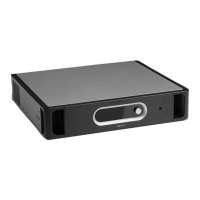36 en | System composition PRAESENSA
2019.11 | V1.00 | Installation manual Bosch Security Systems B.V.
5.3 Amplifier power and crest factor
The PRA-AD604 and PRA-AD608 amplifiers are designed for a maximum loudspeaker load of
600W. Of course the amount of power that is actually delivered to the loudspeakers depends
on the audio signal being amplified. A full scale sinewave signal with an RMS (Root Mean
Square) voltage of 100V into a resistive loudspeaker load of 16.7ohm would cause 600W of
power to be delivered to that load. For this RMS output voltage of 100V, the peak output
voltage is 141V. For a sine wave, the RMS voltage is 3dB lower than its peak voltage. This can
also be expressed as that a sine wave has a crest factor of 3dB, because by definition the
crest factor of a signal is the ratio of its peak level to its RMS level. A square wave signal has a
crest factor of 0dB because its peak level and its RMS level is the same. Pink noise has a crest
factor of 12dB and a typical STIPA test signal has a crest factor of 13dB. The crest factor of
voice signals is approximately 12dB. That is, the peaks of speech are about 12dB more
intense than the average values. This is caused by natural damping of the human vocal tract
due to the nasal cavity, soft cheeks, soft tongue, lips, et cetera. Musical instruments, however,
are not so well damped. Hard walled horns and stiff resonator chambers all yield a physical
musical signal with much higher crest factors. Typical crest factors for musical instruments are
on the order of 18 to 20dB. That is, with musical instruments, peaks tend to be sharper than
for speech. On the other hand, for recorded music the crest factor is often lowered by mixing
of multiple instruments and additional sound processing in order to get a more even output
level, where soft signals don’t disappear in the ambient noise and loud fragments are not
disturbingly loud.
It is sufficient that an amplifier can drive its loudspeaker load to the maximum level only
during peaks; its long term (average) power capability can be much lower. It is generally
accepted that a continuous output power of 1/8 of the maximum sinewave power is sufficient
for most types of music and speech. The PRA-AD604 and PRA-AD608 amplifiers have more
margin and can deliver a continuous RMS output power of 1/4 of the maximum sine wave
power, which is 150W for a 600W amplifier. For short periods of time (bursts) the maximum
output power is 600W. This additional margin is used to play continuous alarm tones at a
relatively high level. An even higher level would not be very useful because PRAESENSA is a
Voice Alarm system, and the loudness of an alarm tone should not be significantly higher than
the loudness of the voice signal, otherwise the voice signal would be perceived as softer and
not very clear.
PRAESENSA uses digital signal processing and transport. The maximum peak voltage of 141V
at an amplifier channel output corresponds to a digital signal level of 0dBFS (dB Full Scale).
The RMS level of a full scale sinewave is 3dB lower, so -3dBFS, corresponding to an RMS
voltage of 100V. In the 70V mode all voltage levels are 3dB lower for the same digital signal
level in dBFS. In order to keep the RMS power at 150W for a 600W loudspeaker load, the
RMS signal level must be 6dB lower. This means that the RMS level of the digital signal should
not be more than -9dBFS. Peaks can be as high as 0dBFS. The PRAESENSA amplifiers have
an integrated RMS power limiter that reduces the signal level to all channels when the
combined output power of all channels together exceeds 150W for a too long time.
PRAESENSA has a library of attention tones, alarm tones and test tones, formatted as
wav‑files. These tones all have an RMS level at or below -9dBFS. For custom made tones this
should not be different. For instance, one of the multi‑sine alarm tones in the audio editing
program Audacity may look like this:

